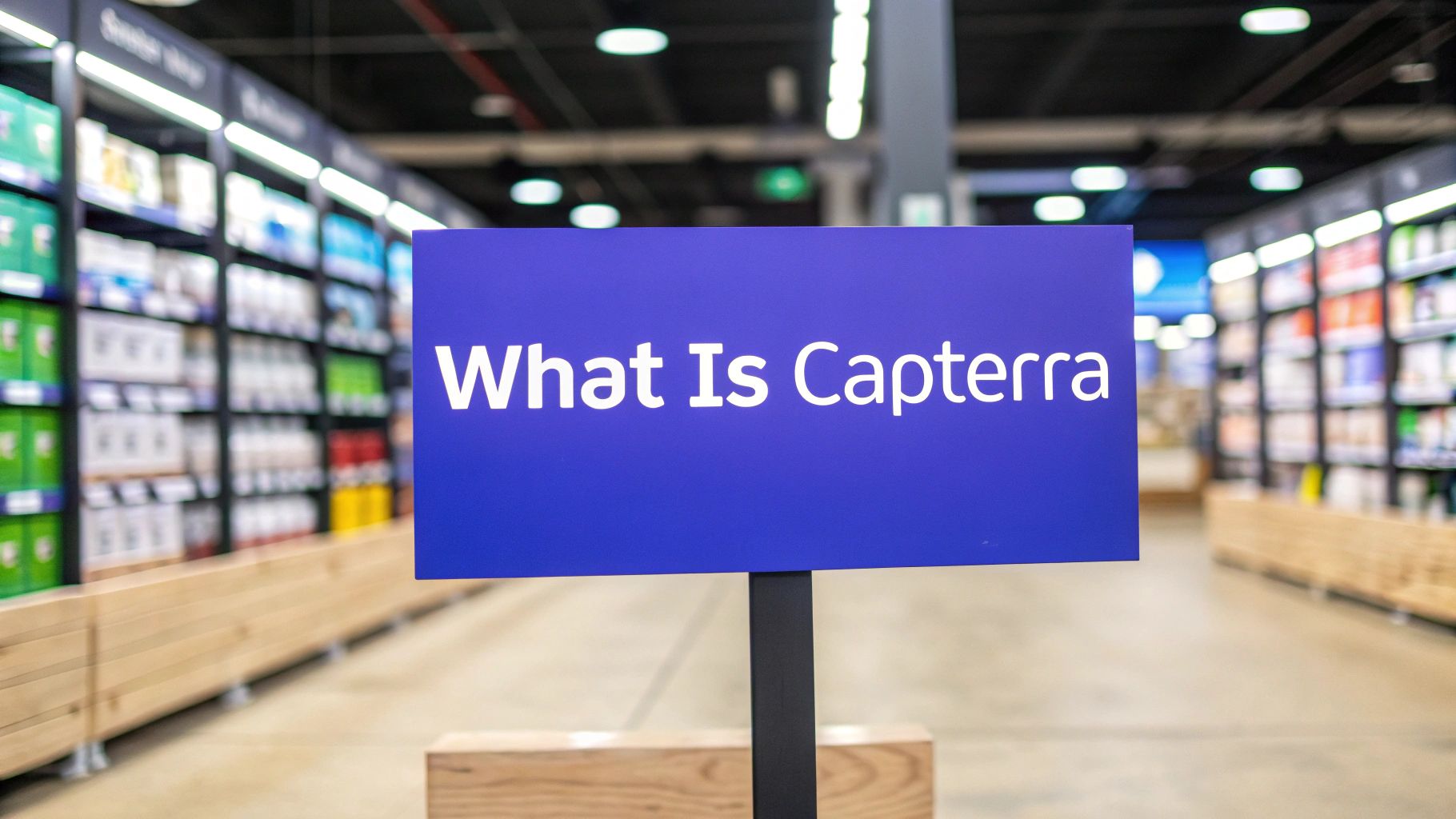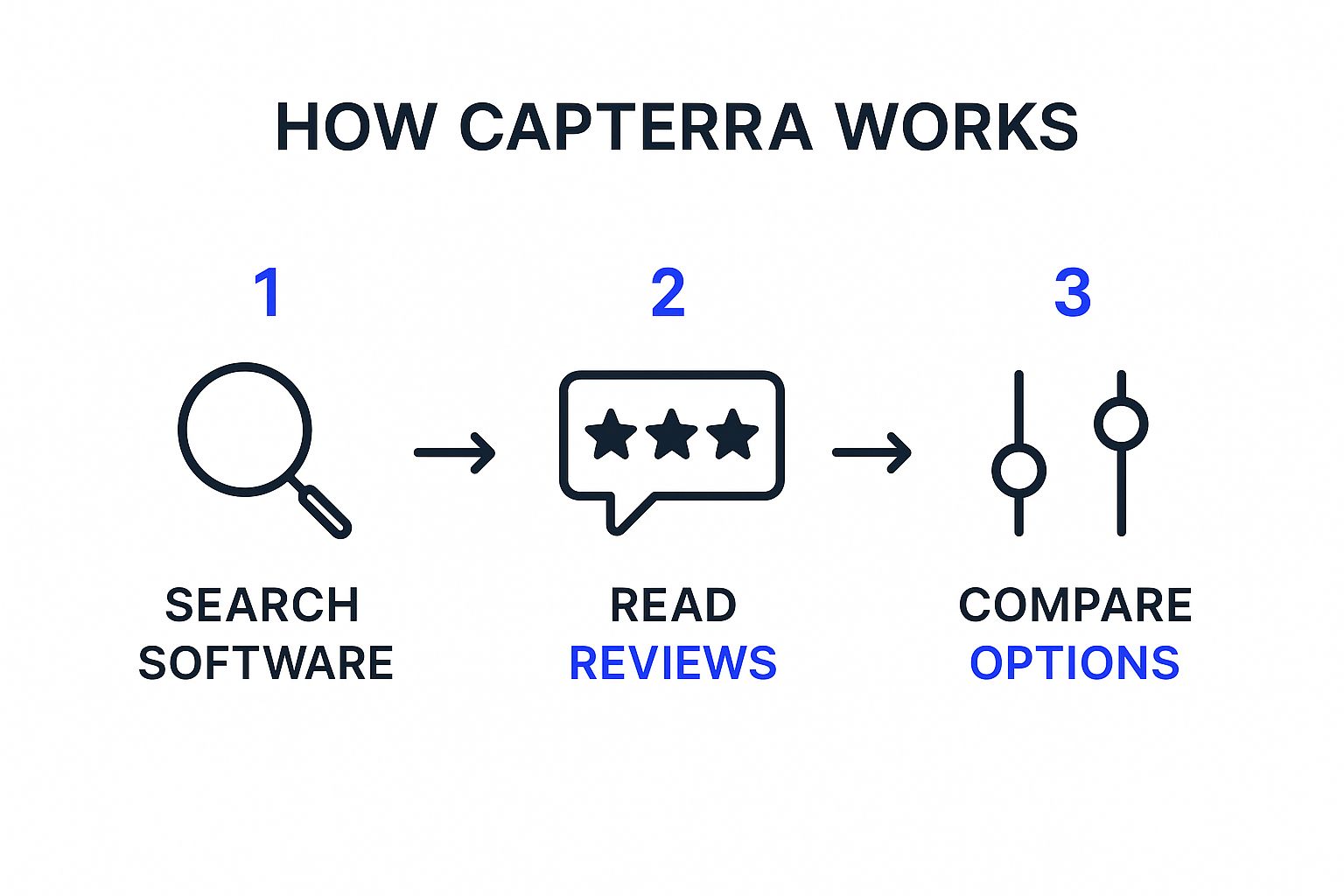What Is Capterra? Your Guide to This Software Marketplace
Wondering what is Capterra? Discover how this software marketplace helps buyers and vendors find the right tools with confidence. Learn more now!

Trying to pick the right software for your business can feel like searching for one specific book in a library the size of a city block with no card catalog in sight. That's where Capterra comes in. Think of it as that digital catalog, a central hub where you can find, compare, and see what real users think about thousands of software options. It makes the whole process a lot less overwhelming.
Your Guide to Navigating the Software Maze
At its heart, Capterra is a massive online marketplace built to connect businesses with the software solutions they need to grow. Instead of bouncing between dozens of different websites trying to piece together information, you get everything you need in one organized, searchable spot.
The sheer scale is pretty impressive. We're talking over 100,000 software products neatly filed into around 900 different categories. But the real gold is the 2 million+ verified user reviews from people who have actually used the tools, giving you honest, unfiltered feedback.
So, What's Capterra's Main Job?
Simply put, Capterra acts as a bridge. For businesses on the hunt for software, it provides clarity in a seriously crowded market. For the software companies themselves, it offers a direct line to potential customers who are actively shopping and ready to buy. This two-way street makes it an indispensable resource for both sides of the coin.
Capterra is part of a larger family of sites, and you can see how it stacks up against one of its siblings in our guide here: https://www.surva.ai/blog/getapp.
Capterra takes the tangled mess of software selection and straightens it out. By bringing product details, user reviews, and comparison tools into one place, it helps businesses make smarter buying decisions with way more confidence.
As you continue your search for the right tools, you might find it helpful to explore guides on essential software tools for various needs.
To give you a clearer picture, here’s a quick breakdown of what Capterra brings to the table for both buyers and sellers.
Capterra at a Glance
Ultimately, whether you're buying or selling, Capterra creates a more transparent and efficient software marketplace for everyone involved.
How Capterra Actually Works for You
Think of Capterra as a highly specialized search engine. But instead of sifting through cat videos or news articles, you're hunting for the perfect software to solve a real business problem.
The journey usually starts when someone realizes they've hit a wall. Maybe their project tracking is a mess, or their team needs a better way to collaborate. They head to Capterra with a problem, looking for a solution.
Right away, they find a clean, organized directory. Users can slice and dice the results by company size, industry, must-have features, or even pricing models. This quickly turns an overwhelming ocean of options into a manageable shortlist of real contenders. From there, they can look into the most valuable part of the platform: the verified user reviews.
This whole process is designed to take you from a vague need to a confident decision without all the usual guesswork. The infographic below breaks it down into three simple steps.

As you can see, it’s a logical path from a broad search to a detailed comparison, making the whole discovery process much simpler.
So, How Does Capterra Make Money?
You might be wondering how Capterra can offer all this for free to software buyers while still running a successful business. The answer is simple: they charge the software vendors, not the users.
Software companies pay Capterra for visibility in front of a massive audience of people actively looking to buy. The most common setup is a pay-per-click (PPC) model. Every time a user clicks on a vendor’s profile from the search results, that vendor pays a small fee. It’s a straightforward way for software companies to get high-quality leads.
This model creates a balanced ecosystem. Buyers get a free, powerful research tool, and vendors get direct access to potential customers at the exact moment they are considering a purchase.
When you think about it, this system really aligns everyone's interests:
- Buyers get to find the best tools based on real-world experiences from their peers.
- Vendors connect with high-intent prospects, making their marketing spend far more effective.
- Capterra acts as the matchmaker, creating value for both sides of the marketplace.
Capterra works because it's built on transparency. It gives buyers a structured path to an informed decision and gives vendors a predictable way to find new customers.
Key Benefits for Software Buyers

If you've ever been tasked with finding new software for your business, you know how chaotic it can get. You end up juggling dozens of browser tabs, trying to piece together features and pricing from one vendor's site to the next. It’s a mess.
Capterra cuts through that noise by putting everything you need in one place. This alone saves a massive amount of time and effort right from the start.
But the real magic is in its 2 million+ verified user reviews. These are firsthand accounts from people who have actually used the software day in and day out. They give you the unvarnished truth, the good, the bad, and the buggy, so you can see past the polished marketing copy and understand how a tool really performs in the wild.
Making Confident Decisions
Once you have a few options in mind, Capterra’s comparison tools make the final call much simpler. You can line up multiple products side-by-side and directly contrast their features, pricing models, and user ratings. This layout makes it easy to spot the subtle differences that could make or break your decision.
By combining objective data with real-world user experiences, Capterra gives you the clarity to avoid a bad investment. A confident choice is always an informed one.
This whole process helps you build a solid shortlist in a fraction of the time. From there, you can dig into the reviews that are most relevant to your specific needs. Hearing from others who’ve walked the path before you is a huge part of the platform's value. In fact, seeing how these reviews influence decisions is a perfect way to understand the power of social proof firsthand.
- Time Savings: All the information is in one spot, so you can stop the endless, scattered research.
- Risk Reduction: Verified reviews from actual users help you sidestep costly purchasing mistakes.
- Informed Choices: Side-by-side comparisons let you make clear, data-driven decisions.
Using a platform like Capterra means you can choose your next software tool with a much higher degree of certainty. If you want to learn how to read between the lines of these reviews, check out our guide on getting the most from your Capterra review.
Why Software Vendors Use Capterra

Sure, Capterra is a goldmine for anyone looking to buy software, but flip the coin, and you'll find it's a powerful marketing engine for the software vendors themselves. For a lot of SaaS companies, a solid presence on Capterra is a core piece of their growth strategy.
And for good reason. The platform gives them a direct line to an audience that's ready to buy.
Think about it. People landing on Capterra aren't just window shopping; they have a specific problem and are actively hunting for a solution. This means the leads that come from the platform are often highly qualified and already deep into the buying cycle. Instead of casting a wide, expensive net with traditional ads, vendors can connect with prospects right at that important decision-making moment.
Capterra’s pay-per-click (PPC) model gives vendors a predictable, controllable way to manage their ad spend while zeroing in on these motivated buyers. This efficient structure was actually the secret to Capterra's own incredible growth. Under its founder Mike Ortner, the company became so scalable it was pulling in roughly $1 million in revenue per employee. That’s a serious indicator of how well its digital marketplace model works. You can get the full story on Mike Ortner's leadership and Capterra's history on sentventures.com.
Building Trust and Credibility
Beyond generating leads, Capterra is a vital space for building a brand's reputation. Positive, verified reviews act as powerful social proof, building trust with potential customers long before they even land on a vendor's website. These authentic testimonials can be the deciding factor for a buyer on the fence.
A strong Capterra profile, packed with positive user feedback, is like a digital seal of approval. It tells the market your product is reliable and genuinely valued by its customers.
In a crowded market, that kind of credibility is a massive advantage. For any company trying to figure out how to best use platforms like this, our article on Capterra dives even deeper.
It boils down to two key reasons vendors flock to Capterra:
- To Generate Qualified Leads: They get to connect with buyers who are actively looking to make a purchase, right now.
- To Build Social Proof: They collect and show off real user reviews that build trust and prove their product's worth.
The Story Behind Capterra
Every great company has an origin story, and Capterra’s kicks off in 1999, right in the thick of the first dot-com bubble. Founder Mike Ortner saw an opportunity and launched the platform as an online marketplace for business software. But the road ahead was anything but easy.
Like a lot of startups from that era, Capterra really struggled to find its footing. It took almost two full years just to land its first couple of paying customers. The initial business model, which was based on renting software, just wasn’t resonating with the market. Surviving the dot-com crash that followed meant they had to make a big change, and fast.
The Pivot that Changed Everything
The company's real breakthrough moment came when it ditched the software rental idea and switched to a pay-per-click (PPC) advertising model. This was a pretty forward-thinking approach at the time. It gave software vendors a much more practical way to control their marketing spend while still getting a steady stream of leads. You can get more of the inside scoop on Capterra's early days and this critical business model shift from Trust Signals.
This pivot from a tricky sales model to a straightforward lead generation platform was the key to Capterra’s survival and eventual success. It aligned the company’s revenue directly with the value it provided to vendors.
By focusing on a model that actually worked for its partners, the bootstrapped company managed to weather the storm. More importantly, it laid the foundation for becoming the industry leader it is today.
Still Have Questions About Capterra?
Even after a good overview, it's normal to have a few lingering questions. Let's tackle some of the most common ones that pop up for both software buyers and vendors.
Is Capterra Free for Finding Software?
Absolutely. For anyone on the hunt for new software, Capterra is 100% free to use. You can search their entire catalog, read millions of reviews, compare different tools side-by-side, and look into all their guides without spending a penny.
So, how do they keep the lights on? Capterra makes its money from the software companies themselves. Vendors pay to be listed on the platform and for the leads they get when you click through to their profiles. This model keeps the site completely free for users like you.
How Can I Trust the Reviews on Capterra?
This is a great question, and Capterra takes it seriously. They have a fairly thorough multi-step process to verify that the reviews are legit. Their team works to confirm that reviewers are real people who aren't secretly working for the company they're reviewing.
Of course, no system is foolproof, but their process is designed to weed out fake or overly biased feedback. Reviewers also have to confirm they aren’t employees or direct competitors, which helps make sure the insights you're reading come from genuine users.
Capterra's rankings are built on objective data and verified customer reviews. This creates a real-world snapshot of which platforms professionals genuinely trust to power their work.
What Is the Difference Between Capterra, Software Advice, and GetApp?
It’s easy to get these three mixed up, especially since they're all owned by the same parent company, Gartner. While they all help you find software, each one offers a slightly different experience.
Think of it this way:
- Capterra: This is your massive, self-service library. It’s known for its huge directory and millions of user reviews, making it perfect if you like to do your own research.
- Software Advice: This is like having a personal shopper. They offer one-on-one phone calls with expert advisors who help you find the right software for your specific needs.
- GetApp: This one is all about playing well with others. It focuses more on mobile apps and how different software tools integrate, which is super helpful for small and medium-sized businesses building out their tech stack.
The best one for you just depends on how you prefer to shop, whether you like to browse the aisles yourself, ask a specialist for help, or focus on how everything will connect.
At Surva.ai, we believe getting to know your users is the key to growth. Our AI-powered platform helps SaaS teams collect actionable feedback, reduce churn, and turn happy customers into powerful testimonials. Learn how you can scale smarter by visiting https://www.surva.ai.


